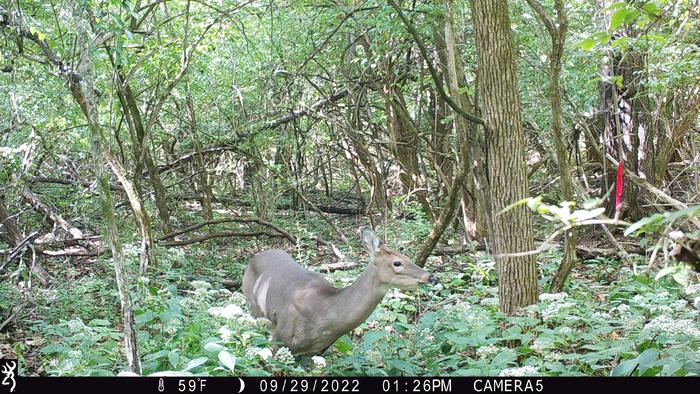In recent studies concerning the dynamics of forest ecosystems, researchers have illuminated the dual challenges posed by overabundant white-tailed deer populations and invasive plant species, particularly Amur honeysuckle. This invasive shrub, known scientifically as Lonicera maackii, poses a significant threat to the regeneration of native deciduous forests, an issue gaining urgency as both these factors interact negatively in the environment. The findings, based on over a decade of research led by David Gorchov, a biology professor at Miami University in Ohio, reveal the profound impacts these stressors can exert on forest health and biodiversity.
The study, conducted in a series of controlled experiments within the Miami University Natural Areas, demonstrates that while managing one of these problematic species may yield some improvement, it is insufficient for long-term ecological restoration. The data revealed a concerning trend: prioritizing the control of invasive honeysuckle without simultaneously addressing deer populations leads not only to limited success but may actually exacerbate native plant cover decline. Gorchov emphasized that the singular approach of either controlling deer or removing invasive shrubs fails to promote the desired forest regeneration.
Forests that are rampant with both white-tailed deer and Amur honeysuckle represent a fragile ecological balance. Deer tend to thrive in these environments, feeding on native plant species while spreading invasive shrubs that further diminish native plant diversity. Gorchov elucidated the interaction’s complexity, asserting that the simple act of excluding deer—while neglecting to remove invasive honeysuckle—yielded noticeable increases in tree seedling density and diversity in the exposed environments. However, the interaction is intricate; the absence of deer allows some invasive species to proliferate unchecked, complicating restoration efforts.
The research team systematically divided their study area into plots that permitted deer access and those that did not. They additionally conducted honeysuckle removal efforts in both settings to gauge the multivariate impacts on forest regeneration. The results reinforced a pivotal conclusion: the most effective strategy for enhancing tree seedling abundance and diversity lies in the combined management of both deer and invasive shrubs. Forest managers and ecologists now recognize that a dual approach is imperative. This realization is critical if we are to maintain the structural integrity and biodiversity of Eastern and Midwestern forests, which are under constant threat from invasive species and unsustainably high herbivore populations.
Among the tree species studied were Sugar Maple, Red Oak, Bitternut Hickory, Black Cherry, and Redbud. The research underscored that these species benefitted significantly from both deer exclusion and the removal of Amur honeysuckle. Interestingly, some invasives, such as Burning Bush and Winter Creeper, thrived in their own right when deer were excluded but honeysuckle remained. This presents an ongoing challenge for land managers who wish to foster a balance between halting invasive proliferation while supporting the growth of desirable native floras.
Failure to regenerate native trees not only threatens current canopies but also diminishes the ecological makeup of these forests, impacting wildlife and plant biodiversity for generations to come. With fewer juvenile trees reaching maturity, the long-term consequences may see diminished forest canopies, with cascading effects on habitat, wildlife, and ecosystem functionality. Gorchov pointed out that focusing solely on eliminating invasive species or regulating deer numbers could lead to an imbalanced ecosystem that lacks resilience against future ecological shifts.
The implications of these findings extend far beyond the immediate study area, resonating throughout the northeastern and midwestern United States, where similar ecological dynamics prevail. As land managers grapple with the realities of invasive species and wildlife populations, these insights provide a guiding framework—one that urges a synergistic approach rather than a piecemeal strategy. It is a call to action, advocating for comprehensive management protocols that acknowledge the interconnectedness of species within forest ecosystems.
The findings were published in the esteemed journal Invasive Plant Science and Management, further emphasizing a growing acknowledgment in the scientific community of the need for interdisciplinary approaches to forest management. As researchers delve deeper into these ecological interdependencies, the hope is that their work will catalyze broader adoption of integrated management practices, ultimately leading to healthier, more resilient forest ecosystems.
By advocating for this comprehensive management of invasive plants alongside herbivore control, we can take significant steps toward revitalizing forest ecosystems for future generations. The study not only highlights the complexities of ecological management but serves as a reminder of the importance of investing in research and conservation strategies that encourage sustainable forestry practices and biodiversity preservation.
As the impacts of climate change and human activity become further pronounced, understanding these dynamics will be crucial in shaping our responses to environmental challenges. This research lays the groundwork for future studies that will continue to explore and refine strategies for effective ecological restoration. By changing the conversation around forest management to include multiple interacting species, we can forge pathways for restoring balance in ecosystems struck by imbalance via invasive species and herbivore pressures.
Subject of Research: The interactive impacts of the invasive shrub Lonicera maackii and white-tailed deer (Odocoileus virginianus) on forest ecosystems.
Article Title: Long-term interactive impacts of the invasive shrub Lonicera maackii and white-tailed deer (Odocoileus virginianus) on a deciduous forest understory.
News Publication Date: 29-Jan-2025
Web References: N/A
References: N/A
Image Credits: Elea Cooper
Keywords: Invasive species, forest management, white-tailed deer, Amur honeysuckle, tree regeneration, biodiversity, ecological restoration, forest ecosystems.




